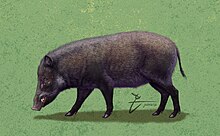128:
111:
146:
303:
was larger than the modern day wild boar. A skeleton from a young specimen indicates an animal of 150 cm (4.9 ft), while incomplete remains from an adult indicate an animal with a head-and-body length of 183 cm (6.00 ft). One recently found fossil was a 35 cm (14 in)
338:
364:
460:
450:
465:
440:
119:
455:
445:
339:"Ricerca dell'Università di Perugia, ecco l'antenato del cinghiale scoperto in Umbria: Un bestione da record"
145:
375:
407:
241:
127:
435:
140:
412:
110:
308:. It was possibly adapted to a swamp environment, and may have been ancestral to the modern
288:, and was eventually displaced by the latter when it entered Europe during the start of the
309:
351:
Kurtén, Björn (1968). Pleistocene mammals of Europe. Weidenfeld and
Nicolson. pp. 153-155
429:
277:
61:
328:
Biology and wildlife of the
Mediterranean region, By Jacques Blondel, James Aronson
289:
217:
197:
36:
398:
304:
jawbone from a male, much larger than the jawbone of any modern day species of
81:
46:
285:
157:
86:
392:
177:
76:
71:
56:
51:
41:
91:
66:
281:
273:
207:
187:
167:
369:
373:
365:
Reconstruction at AmSturDam - Genealogie & Paleontologie
382:
8:
370:
126:
109:
20:
321:
7:
14:
144:
284:. It was more ancient than the
120:Naturhistorisches Museum, Basel
1:
461:Fossil taxa described in 1881
451:Prehistoric mammals of Europe
482:
32:Pliocene–Early Pleistocene
466:Mammals described in 1881
247:
240:
141:Scientific classification
139:
134:
125:
117:
108:
23:
16:Extinct species of mammal
441:Pleistocene Artiodactyla
456:Pliocene Artiodactyla
408:Paleobiology Database
135:Life reconstruction
260:Forsyth Major, 1881
446:Prehistoric Suidae
423:
422:
376:Taxon identifiers
265:
264:
473:
416:
415:
403:
402:
401:
371:
352:
349:
343:
342:
335:
329:
326:
256:
252:
149:
148:
130:
118:Skeleton at the
113:
103:
33:
29:Temporal range:
21:
481:
480:
476:
475:
474:
472:
471:
470:
426:
425:
424:
419:
411:
406:
397:
396:
391:
378:
361:
356:
355:
350:
346:
337:
336:
332:
327:
323:
318:
310:Javan warty pig
298:
261:
258:
250:
249:
236:
233:S. strozzi
143:
104:
102:
101:
100:
99:
94:
89:
84:
79:
74:
69:
64:
59:
54:
49:
44:
39:
31:
30:
27:
17:
12:
11:
5:
479:
477:
469:
468:
463:
458:
453:
448:
443:
438:
428:
427:
421:
420:
418:
417:
404:
388:
386:
380:
379:
374:
368:
367:
360:
359:External links
357:
354:
353:
344:
330:
320:
319:
317:
314:
297:
294:
276:native to the
263:
262:
259:
245:
244:
238:
237:
229:
227:
223:
222:
215:
211:
210:
205:
201:
200:
195:
191:
190:
185:
181:
180:
175:
171:
170:
165:
161:
160:
155:
151:
150:
137:
136:
132:
131:
123:
122:
115:
114:
106:
105:
97:
96:
95:
90:
85:
80:
75:
70:
65:
60:
55:
50:
45:
40:
35:
34:
28:
15:
13:
10:
9:
6:
4:
3:
2:
478:
467:
464:
462:
459:
457:
454:
452:
449:
447:
444:
442:
439:
437:
434:
433:
431:
414:
409:
405:
400:
394:
390:
389:
387:
385:
381:
377:
372:
366:
363:
362:
358:
348:
345:
340:
334:
331:
325:
322:
315:
313:
311:
307:
302:
295:
293:
291:
287:
283:
279:
278:Mediterranean
275:
271:
270:
257:
255:
246:
243:
242:Binomial name
239:
235:
234:
228:
225:
224:
221:
220:
216:
213:
212:
209:
206:
203:
202:
199:
196:
193:
192:
189:
186:
183:
182:
179:
176:
173:
172:
169:
166:
163:
162:
159:
156:
153:
152:
147:
142:
138:
133:
129:
124:
121:
116:
112:
107:
93:
88:
83:
78:
73:
68:
63:
58:
53:
48:
43:
38:
26:
22:
19:
384:Sus strozzii
383:
347:
333:
324:
305:
300:
299:
268:
267:
266:
253:
248:
232:
231:
218:
198:Artiodactyla
24:
18:
436:Sus (genus)
301:Sus strozzi
296:Description
290:Pleistocene
269:Sus strozzi
254:Sus strozzi
25:Sus strozzi
430:Categories
316:References
280:region of
292:, 1 Mya.
226:Species:
164:Kingdom:
158:Eukaryota
399:Q7647453
393:Wikidata
204:Family:
188:Mammalia
178:Chordata
174:Phylum:
168:Animalia
154:Domain:
251:†
230:†
214:Genus:
194:Order:
184:Class:
98:↓
413:473556
282:Europe
272:was a
208:Suidae
286:boar
274:suid
37:PreꞒ
306:Sus
219:Sus
432::
410::
395::
312:.
87:Pg
341:.
92:N
82:K
77:J
72:T
67:P
62:C
57:D
52:S
47:O
42:Ꞓ
Text is available under the Creative Commons Attribution-ShareAlike License. Additional terms may apply.



